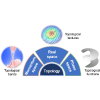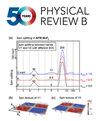双叶黎曼曲面拓扑反转磁电性
IF 3.7
2区 物理与天体物理
Q1 Physics and Astronomy
引用次数: 0
摘要
电场控制固体中的磁性,即相反的磁电性,是可扩展高能效逻辑器件应用所亟需的。然而,这不仅是一项技术挑战,也是一个科学悖论,因为原则上电自由度和磁自由度遵循不同的对称规则。尽管多铁氧体界在过去几十年中取得了巨大进步,但磁电的成功仍在路上,迫切需要更多具有概念革命的替代方法。在这里,通过将拓扑学概念引入多铁氧体,基于二维磁体中自旋依赖的 d-p 杂化机制,揭示了一种奇特的磁电双叶黎曼面:GdI2单层。在拓扑结构的保护下,电循环可以精确地实现 180∘自旋反转,从而产生稳健、无耗散的反向磁电功能。这种拓扑磁电性允许通过交流电场对磁化进行非简单的操纵。在这类材料中,有针对性地设计出了更多性能更佳的候选材料,为拓扑磁电的潜在应用铺平了道路。本文章由计算机程序翻译,如有差异,请以英文原文为准。

Double-leaf Riemann surface topological converse magnetoelectricity
Electric field control of magnetism in solids, i.e., the converse magnetoelectricity, is highly desired for applications of scalable energy-efficient logic devices. However, it is not only a technical challenge but also a scientific paradox, since in principle the electric and magnetic degrees of freedom obey distinct rules of symmetries. Despite the great progress obtained in the community of multiferroics during the past decades, the success of magnetoelectricity remains on its way and more alternative approaches with conceptual revolution are urgently needed. Here, by introducing the concept of topology into multiferroics, an exotic magnetoelectric double-leaf Riemann surface is unveiled based on the mechanism of spin-dependent hybridization in a two-dimensional magnet: monolayer. Protected by the topology, a spin reversal can be precisely achieved by an electric cycle, leading to a robust and dissipationless converse magnetoelectric function. Such a topological magnetoelectricity allows the nontrivial manipulation of magnetization by ac electric field. In this category, more candidate materials with better performance are designed targetedly, which paves the road to the potential applications with topological magnetoelectrics.
求助全文
通过发布文献求助,成功后即可免费获取论文全文。
去求助
来源期刊

Physical Review B
物理-物理:凝聚态物理
CiteScore
6.70
自引率
32.40%
发文量
0
审稿时长
3.0 months
期刊介绍:
Physical Review B (PRB) is the world’s largest dedicated physics journal, publishing approximately 100 new, high-quality papers each week. The most highly cited journal in condensed matter physics, PRB provides outstanding depth and breadth of coverage, combined with unrivaled context and background for ongoing research by scientists worldwide.
PRB covers the full range of condensed matter, materials physics, and related subfields, including:
-Structure and phase transitions
-Ferroelectrics and multiferroics
-Disordered systems and alloys
-Magnetism
-Superconductivity
-Electronic structure, photonics, and metamaterials
-Semiconductors and mesoscopic systems
-Surfaces, nanoscience, and two-dimensional materials
-Topological states of matter
 求助内容:
求助内容: 应助结果提醒方式:
应助结果提醒方式:


